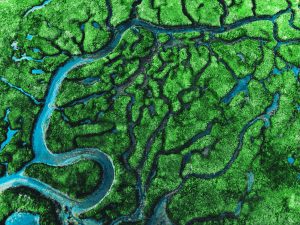 A recent Black & Veatch survey of water, wastewater, and stormwater professionals found that nearly 80% of water utility stakeholders see aging infrastructure as the most challenging issue facing their industry today. This ongoing situation comes as the industry grapples with the related issues of high operational expense, unsustainable energy consumption and water loss levels, and an aging and shrinking workforce. The dilemma has always been too few funds to modernize core pumping and piping networks and the water and wastewater automation solutions that control them.
A recent Black & Veatch survey of water, wastewater, and stormwater professionals found that nearly 80% of water utility stakeholders see aging infrastructure as the most challenging issue facing their industry today. This ongoing situation comes as the industry grapples with the related issues of high operational expense, unsustainable energy consumption and water loss levels, and an aging and shrinking workforce. The dilemma has always been too few funds to modernize core pumping and piping networks and the water and wastewater automation solutions that control them.
Fortunately, new Industry 4.0-related digitalization technologies now make affordable infrastructure modernization possible. One example of this is the recent introduction of industrial automation products that enable the concept of universal automation. This concept allows industrial automation platforms to be built on software-defined, asset-centric, vendor agnostic architectures.
When innovative solutions are introduced into water and wastewater operations, users realize three benefits above and beyond system modernization:
- Lower implementation costs – The ability to connect to new and more innovative apps enables more creative and less expensive approaches to address costly issues such as leak management, energy consumption, and asset With the implementation of systems like EcoStruxure Automation Expert, you can create a complete digital lifecycle for your automation system meaning new challenges can be met faster, with less risk.
- Future proof workforce – As the generation of water and wastewater workers who’ve kept the water flowing for decades retire, specialized knowledge is lost. Next-generation workers come into water utilities viewing today’s proprietary automation systems as archaic and as obstacles to more efficient operations. New systems such as EcoStruxure Automation Expert provide the simplicity of IT-like solutions and are intuitive for younger workers who are used to the concept of easy application portability (take for example smartphone apps that work on any brand of phone). This saves on training time and expense and lowers the risk of operational errors moving forward.
- Increase operational sustainability – In water and wastewater operations, sustainability represents more than low energy consumption and CO2 emissions (although these are important considerations as the water sector accounts for approximately 4% of the electrical energy consumption worldwide). Other sources of waste, such as water leakage, are also a significant sustainability concern. In fact, the World Bank estimates that between 25-35% of water is lost, on average, during pumping and pipeline transport operations. Digital solutions, that take a holistic approach to automation solutions like EcoStruxure Automation Expert, can record and track far more operational data and share that data with those individuals who need it across all departments so that better decisions can be made to drastically reduce the amount of water, energy, and chemical process waste.
Interoperable automation removes technology constraints
One universal automation solution, EcoStruxure Automation Expert, is an application-centric versus controller/device-centric solution, which results in the decoupling of hardware and software. In other words, the software is no longer tied to hardware. End users are free to design or adapt systems to enable a more flexible response to ever-changing supply and demand-side business conditions. Compared with traditional hardware automation systems, EcoStruxure Automation Expert makes the interoperability of software applications far less complex and time-consuming.
It is designed to handle both real-time control and any-time services (IT/OT convergence). Rather than having to build and purchase IT/OT gateways, EcoStruxure Automation Expert embeds native IT/OT integration. This approach emphasizes simplifying the user experience for all stakeholders, be they engineers, plant operators, systems integrators, or machine builders.
This software-defined solution allows users to take advantage of greater levels of flexibility and choice. Users can select the best solution from the most innovative software available in the marketplace to address issues such as water leakage from aging pipe networks and the need to improve the operational efficiency of pumping operations. By unifying the control of plants and water collection and distribution systems a more circular process is enabled, minimizing the amount of freshwater used while maximizing wastewater reuse.
Asset-centric automation saves time and effort
EcoStruxure Automation Expert enables a proper asset-centric system, from the design phase to the lifecycle’s operation and maintenance stages. Designs can be simulated virtually, off-line, so that “what if” scenarios can be tested before deployment to assure optimization of the new asset. Once an asset, like a new pump, is defined as a digital asset, deployment is drag and drop in the end-user interface. The design information (including electrical, mechanical, and control data) can be part of that asset. During operation, any operator or technician who needs access to the information can either optimize performance or troubleshoot any issues. The information is automatically kept up to date throughout the lifecycle of the asset.
This drastically simplifies the life of engineers, control room operators, and maintenance personnel because they have access to one up-to-date version of the truth concerning a particular asset such as a pump. The service technician, for example, may have access to the manufacturing data, the electrical data and may have online access to updated manuals. As a result, the mean time to repair (MTTR) is much shorter; the technician does not have to hunt in multiple places for the data he needs to perform the proper maintenance. Access to updated information also improves overall uptime and reliability.
Evolution instead of revolution
Deploying a solution such as EcoStruxure Automation Expert is not an all-or-nothing proposition. Most water and wastewater stakeholders can choose to start on a smaller scale, e.g., even with a single pumping station. EcoStruxure Automation Expert uses a unique “wrap and replace” approach, incorporating existing legacy designs into the new control system. This approach preserves current investments and the “look and feel” of designs that staff are familiar with, helping to make the most of available capital and minimizing training needs.
New systems and existing systems can run together, gathering and sharing performance data in a more gradual, less costly, less disruptive approach to system modernization. The benefits of interoperability and new, cost-effective applications then be gradually scaled up (along with their financial benefits) across the entire water cycle.
To discover more about how products like EcoStruxure Automation Expert can forever change the way we automate operations, download our white paper “Universal Automation: A Call for Change.”



